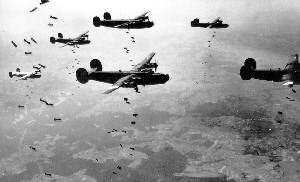"The box the B-17 came in"
"The Flying Boxcar"..."The Buzzin' 2 Dozen" also known as The Consolidated B-24 "Liberator" |
This great bomber owed its strength and success to a unique wing sold to Consolidated in 1937 by a near-destitute inventor by the name of David R. Davis. Although the president of Consolidated, Reuben H Fleet, was sceptical, wind tunnel tests showed that Davis' slender wing with sharp camber provided superior 'lift'.
Consolidated Aircraft Corporation of San Diego, California were established designers and manufacturers of large flying boats. As a result of French and British inquiries, in the late 1930s preliminary design studies of land-based heavy bombers were undertaken. In early 1939, Consolidated was approached by the U.S. Army Air Corps with a request to undertake licence production of the Boeing B-17. They countered with a proposal to build a new and better bomber of their own design. The Air Corps showed interest but requested basic layout information within a matter of days. It is understandable then, that Consolidated's chief designer, Isaac Laddon, shortened both design and prototype construction time by using the wing, engine arrangement, and tail, from their latest flying boat.
The prototype XB-24, which the manufacturer dubbed the Model 32, completed its first flight from San Diego on 28 December, 1939. Performance was pretty much as had been expected. The high aspect ratio wing allowed for faster speeds than other wings in use at the time. The XB-24 was capable of hauling twice the bomb load of the B-17 with a range 200 miles greater. With the forward bomb bays converted to additional tanks, the effective range could be extended to 4000 miles.
Eventually the XB-24 was selected for large scale production as the USAAC's major heavy bomber. With war already underway in Europe, the LB-30 export Liberator came ahead of U.S. versions, and contributed to their development.
As for the XB-24, it was powered by Pratt & Whitney R-1830-33 engines rated at 1100 hp. In March 1939 the U.S. Army ordered seven YB-24 service-test bombers with turbo-superchargers for high-altitude flight. Next came nine B-24Cs, none of which saw combat, and the B-24D which fought everywhere. The turret-equipped B-24H model, appeared on 30 June 1943, followed by the B-24J, L, M, which had full gun armament, including nose turret.
The Consolidated factory could not keep up with the demand and the U.S. government awarded contracts to other companies to produce the aircraft. Between the years of 1939 and 1945, 19,256 of these planes (in several versions) were produced by Consolidated Vultee, Ford Motor Company, Douglas Aircraft and North American Aircraft. At the height of the war effort, Ford's Willow Run, Michigan factory was turning out one new B-24 every 55 minutes. Today there are only two flight-worthy B-24's in existence, and it's history and role in WW II is only dimly recalled except by those who flew in them.
The other four-engine heavy bomber, the Boeing B-17, received most of the publicity, particularly in the strategic air campaign against the Germans in Europe. Among pilots who flew both, it is said the B-17 was much easier to handle. Yet B-24's outnumbered the B-17's even there. B-24's could fly faster, farther, carry a bigger bombload and take more punishment from enemy fire than the fabled B-17. But as all B-24 crewmen knew, the B-17 had one feature that the B-24 never had, a built-in press agent! Some say this is because it was a prettier aircraft. Some contend it was because the B-17 airbases were close to London and the press photographers didn't venture far from the comforts of the city. There just was no way for an airplane known as the "Box Car" to compete in the public's eye with the fabled "Flying Fortress."
The B-24 had a wing span of 110 ft. and was 67 ft. nose to tail. A fully armed and combat-ready B-24 carried a crew of ten men. Its gross weight when loaded was greater than 60,000 pounds. It had, in the most common versions, four movable turrets, each with two .50 caliber machine guns and two individual .50s in the waist, making a total of ten. It was powered by four 1,200 horsepower turbocharged Pratt & Whitney engines and carried 2,750 gallons of fuel. Many B-24 missions were round trips of 1,500 miles and some extended ranges were near 2,000 miles. By the end of World War II, the entire Pacific theater heavy bomber force had been converted to B-24s due to the long range and superior flight characteristics.
faster, farther, and take more
punishment than any other
plane in World War II."
The most common bomb-load was ten 500 pound bombs or five 1,000 pounders. It's operating environment against heavily defended targets in the European Theater was from 18,000 to 28,000 feet, although many missions (particularly in the Pacific) were flown at much lower altitudes. The planes were not pressurized or heated; crewmen wore oxygen masks and electrically heated suits on high altitude missions and were exposed to temperatures that reached minus 30 degrees farenheit and below.

Credit for this page to:
B-24 Liberator at War by Roger Freeman
For more information on the B-24 Liberator please visit the
The Collings Foundation website and their associated historic preservation, The Last Liberator.